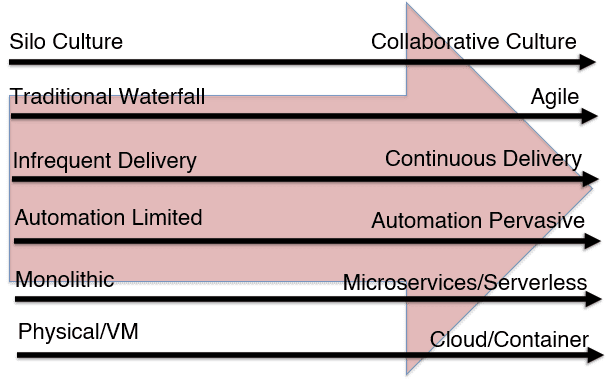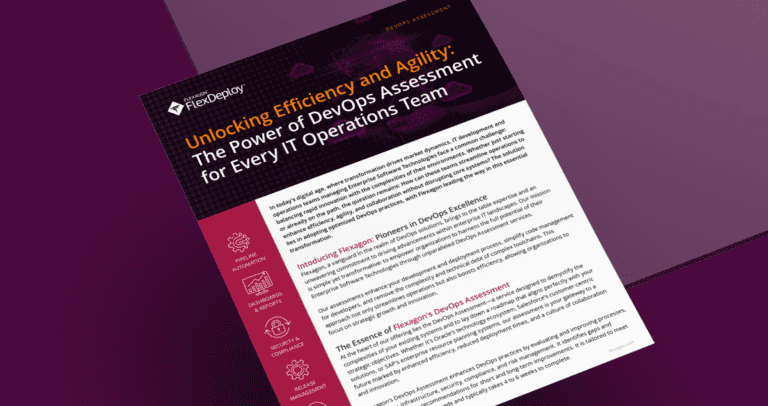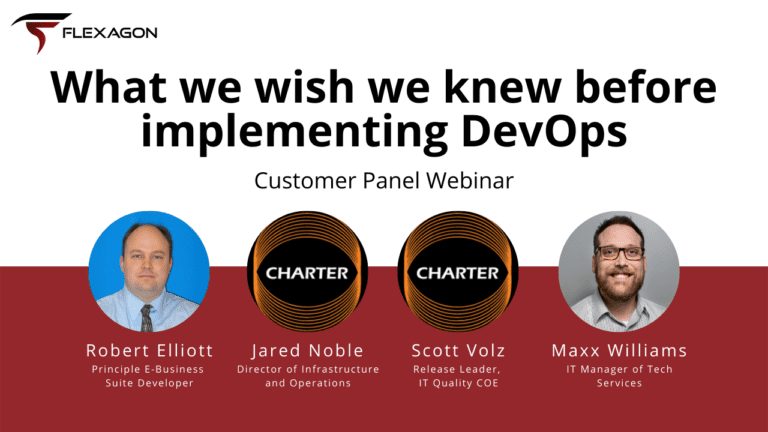The following is a summary of the information covered in the webinar: 5 DevOps Mistakes to Avoid. You can watch the recording here.
Most enterprises are somewhere along their DevOps journey to address software delivery challenges concerning cost, speed, and quality.
DevOps is founded on solving these issues by marrying development and operations and automating activities. While it has frequently proven to achieve the benefits touted, there are many learnings from those who have worked their way down the DevOps path.
Let’s explore 5 mistakes you should avoid while you’re on your DevOps journey.
Defining DevOps
Before discussing what you should and shouldn’t do during the implementation of DevOps, it’s essential to know what DevOps is.

There are a plethora of varying definitions so let’s keep it simple: DevOps is the collaboration and automation of Development, Operations, and QA to create a culture of communication, improve processes, and advance in technology and tools.
Automation is at the core of this definition, allowing for the enablement of DevOps best practices and, ultimately, the reaping of numerous benefits, including:
- Faster time-to-market and time-to-feedback
- Improved customer satisfaction
- Increased ability to build the right solution
- Better product quality
- More reliable releases
- Improved productivity
- Decreased cost and risk
Other important players include security, integrated toolchains, test and quality automation, an agile mindset, a collaborative culture, and continuous everything: continuous integration, continuous delivery, and continuous deployment.
Mistake #1: Either/Or Thinking Across People, Process, or Technology
To combat the challenges of modern software development and delivery, enterprises need to improve 3 areas: people, processes, and technology.
People and processes are closely related as your processes and systems define your organizational culture. For example, siloed processes lead to a sharp distinction between teams, like Dev and Ops. Other traditional processes and technologies include monolithic architectures, physical servers, and waterfall methodologies.
Conversely, modern practices include collaborative teams and a product-focus mindset. Processes should be increasingly Agile, such as continuous delivery and pervasive automation. Finally, new technology should be adopted, including cloud, containers, microservices, APIs, and serverless.

Enterprises of any size have people, processes, and technology that range across the continuum of traditional to modern.
The mistake lies in becoming hyper focused on one or two of these. Organizations that try to boil the ocean won’t achieve the results they are seeking.
DevOps requires all three: a shift in culture, the embrace of agile processes, and the adoption of new technologies.
Only with this strategic approach can organizations establish a collaborative and product-centric nature. Teams can achieve their goal of an ongoing stream of new capabilities, enhancements, and bug fixes, pleasing their internal and external customers.
Mistake #2: Thinking Dev OR Ops
Organizations often ask if processes are development-orientated or operations-orientated. This stems from the conflict traditionally associated with the goals of development and the goals of operations.
Developers want to build software, integrate systems, and move as quickly as possible. On the other hand, operations teams want stability, security, and control, which aren’t typically associated with speed.
Organizations make a mistake when they decide to only focus on Dev or put all their effort into Ops.
The goal is to drive collaboration between these two groups with DevOps. This is achieved when organizations recognize the conflict and separation between Dev and Ops and reward collaboration between the teams.
Everyone is there to achieve the same goal: develop and deliver high quality software quickly while reducing cost and risk to benefit the organization and please end customers.
As a leader in DevOps solutions, we offer a DevOps Assessment tailored to revolutionize your IT operations, ensuring you’re always a step ahead.

Mistake #3: Missing Out on Deployment Strategies
Depending on where an organization is in their journey to DevOps, they may or may not have investigated and implemented deployment strategies.
These strategies focus on ensuring deployments are high-quality and risks are managed. This is done through both processes and enabling technologies.
Deployment strategies include A/B, Blue/Green, and Canary. Each recognizes that there are many types of changes and not all are the same standard.
Applying these means testing changes to verify their quality and executing them with confidence. This process can be repeated via continuous experimentation.
The benefits of rapidly moving changes into live environments in a controlled fashion are reduced downtime and decreased risk. On a larger scale, companies become more effective, rolling out high quality changes to their end users more often.
Adopting deployment strategies may not be the first thing you do as you implement DevOps, but it’s a mistake to miss out on its benefits of applying more advanced forms of deployment as your DevOps implementation matures.
Mistake #4: Focusing Only on Cost Savings
The bottom line enters the discussion for any IT purchase or process. Investments in DevOps can seem costly and daunting at first sight, but ROI can be achieved quickly. Download this whitepaper to learn how to calculate ROI.
With that said, costs savings should not be the only focus.
Once of the major benefits of DevOps is the reduction of manual labor and scripting. Less manual certainly reduces cost, and it also means fewer human errors. This reduces the risk of deployment related outages across environments and saves time because there are fewer deployment related errors and consequential debugging.
Additionally, automation increases the speed and frequency of software delivery. This helps you keep up with your competitors and the industry at large which is moving at an ever increasing pace.
Employee satisfaction and retention increases with the decrease in manual, tedious steps. Developers can now do what they love: developing!
In the long run, these benefits will save you money. When employees are more productive and happier, they have greater outputs, the products/changes are better, your end users are satisfied, and you don’t have the expensive onboarding costs of hiring new employees.
Mistake #5: Failing to Start OR Applying the Big Bang Theory
The biggest way to fail at DevOps is to never start. It may seem like a huge, intimidating task, but remember that “DevOps” means many different things. Most companies are somewhere in their journey.
You may be getting beaten up in the market as you aren’t as competitive. You may be overanalyzing the situation and psyching yourself out about the investment, whether that is time or money.
It’s all about the next step. Don’t wait. The risks associated with doing nothing are far greater than starting.
Take one same step at a time. Break the problem space down. Start learning and be continuously learning as you apply new DevOps techniques. Soon these actions will snowball and result in a mature DevOps implementation.
Conversely, some will make the mistake of taking extreme measures to start and refine a DevOps strategy and implementation (i.e., the Big Bang Theory).
This is not as common today as it was in the past because many companies that took this path failed at their implementations. These failures showed the importance of a phased approach.
The Biggest Barrier to DevOps
In this clip, three customers share the biggest barriers they faced when they undertook their transformations to DevOps.
Each customer, in their own way, described a struggle with change management. While adopting new processes and technology are essential, don’t forget about the third dimension of DevOps: people. It’s critical to get others at your organization to invest their time and energy to the DevOps transformation.
Access the full webinar today to hear more on these 5 mistakes so you can successfully continue your journey to DevOps.

Want to keep learning? Check out other on-demand and upcoming webinars.



